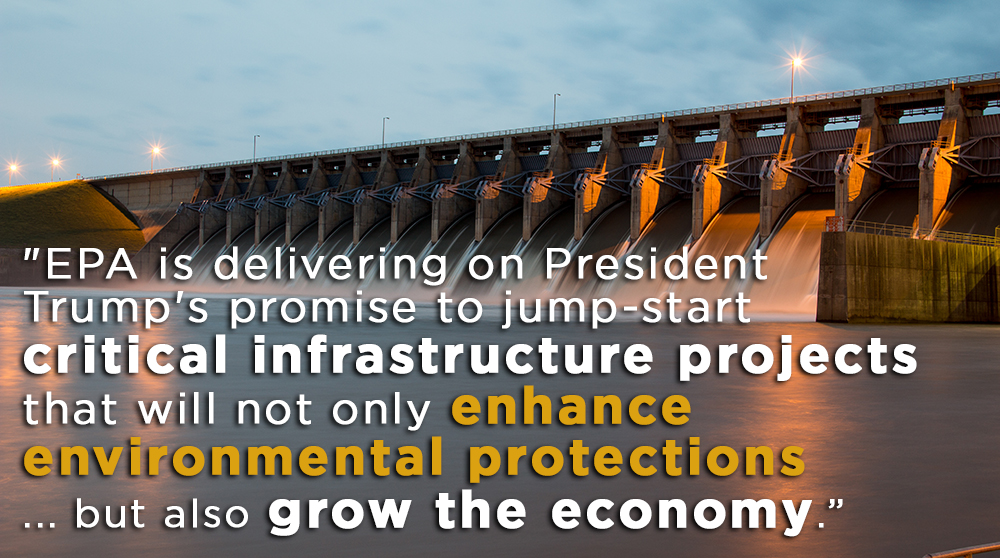President Trump is inviting local and state governments to “Build a Stronger America” through investment in infrastructure. The president’s plan is to spur $1.5 trillion in investment by distributing $200 million in matching grants, while putting decision making into state and local hands, streamlining permitting and removing regulatory barriers.
Grants Highlighted
Environmental Protection Agency Acting Administrator Andrew Wheeler has been highlighting grants distributed through the Water Infrastructure Finance and Innovation Act, or WIFIA, this month. WIFIA provides long-term, low-cost loans for water infrastructure projects. The program is meant to fund innovations such as improving energy efficiency at water treatment and waste water plants; desalination, aquifer recharge, alternative water supplies and recycling water; and drought prevention, reduction and mitigation.
“EPA is delivering on President Trump’s promise to jump-start critical infrastructure projects that will not only enhance environmental protections but also grow the economy,” Wheeler said. “Under President Trump, EPA has issued seven WIFIA loans to help finance over $4 billion in water infrastructure projects that will improve water quality and create up to 6,000 jobs.”
Among those projects receiving funding were the Metropolitan St. Louis Sewer District, which received $47.7 million to construct a new pump station and rehabilitate or replace sewer pipes to improve Deer Creek’s water quality and reduce inflow and infiltration, and the City of Omaha’s Saddle Creek Retention Treatment Basin Project, which received $69.7 million for a wastewater pump station to decrease untreated combined sewer overflow from entering Little Papillion Creek. It’s estimated that these projects will save $15 million and $20 million, respectively, over other funding sources.
WIFIA Loans
In November, the EPA requested that officials managing another nearly 40 projects submit applications for WIFIA loans, and those selected in this round will receive $5 billion in financing, leveraging more than $10 billion in water infrastructure spending.
“By clearly defining where federal jurisdiction begins and ends, our new proposed Waters of the U.S. definition will provide states and the private sector the regulatory certainty they need to develop and streamline projects that will modernize our nation’s aging infrastructure,” Wheeler added.
Under the proposed Waters of the U.S., or WOTUS, navigable waters and their tributaries, impoundments of jurisdictional waters, wetlands adjacent to jurisdictional waters and some lakes and ponds would be federally regulated. Groundwater, most ditches, converted cropland, storm water and wastewater treatment systems and those features that only hold water during or after rainfall would not be considered waters of the United States.
Clean Drinking Water
The EPA also administers the Clean Water and Drinking Water State Revolving Funds, distributing federal money to states, which then match those funds and distribute them through low-interest, low-cost loans to local projects. Since the Clean Water revolving fund was established in 1987, the federal government has invested $42 billion, which, combined with state dollars, has seen more than $126 billion used to construct wastewater treatment plants. In addition, the government will build green infrastructure and decentralized treatment systems, control pollution sources and protect estuaries through the end of 2017. Since the Drinking Water revolving fund was set up in 1996, the federal government has invested $19.1 billion, leveraging a total of $35.4 billion through the end of 2017. Funds have been used to improve treatment plants, distribution centers, replace or build water storage tanks and improve supply sources.
For example, the Tennessee Department of Environment and Conservation recently announced plans to distribute $66.8 million in low-interest loans, including two loans totaling $24 million to address inflow and infiltration issues in Chattanooga. The department distributes an average of $90 million in revolving loans each year, with 20-year loan periods and interest rates at 1.56 percent.
Congress understands the importance of these programs to our infrastructure, and in the bipartisan spending bill passed in February, state revolving funds remained at current funding levels while the WIFIA was given a small boost. In 2018, the state revolving funds committed to $9.6 billion in infrastructure loans.
We know that our water infrastructure is at a crossroads, and we need to pour billions of dollars into systems built during the middle of last century – or earlier – that are reaching the end of their usable life spans.
Rebuild With Us
The National League of Cities also is encouraging members to “Rebuild With Us” – looking at how local projects can be sustainably funded through both tried-and-true and alternative funding sources, leveraging federal-local partnerships, while innovating to make member communities even stronger than before.
The NLC Service Line Warranty Program can help achieve similar results on the private side. Many homeowners don’t realize they’re responsible for the service lines on their side of the meter – a whopping 60 percent either have no idea who is responsible for the repairs or believe someone other than themselves are responsible. The program educates homeowners about their responsibilities, and offers affordable water and sewer repair plans.
The NLC Service Line Warranty Program has two award-winning customer service centers with over 500 live agents to answer claims calls 24/7/365, and a nationwide network of 1,400 rigorously vetted, licensed and insured local contractors to execute repairs.
Contact us to learn how you can help improve private water infrastructure while giving your residents peace of mind.


